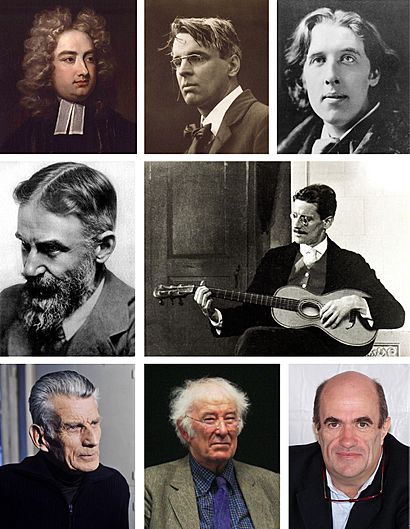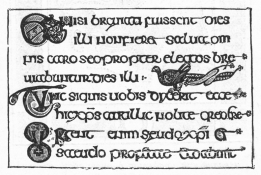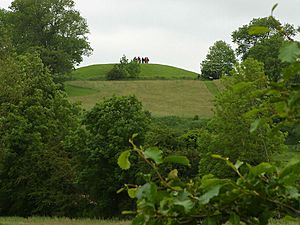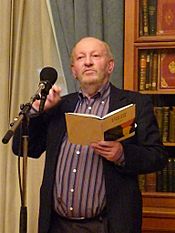Irish literature facts for kids
Irish literature is all the amazing stories, poems, and plays written on the island of Ireland. These works can be in different languages, like the Irish (also called Gaelic), Latin, English, and Scots (especially Ulster Scots).
The very first Irish writings appeared around the 7th century. Monks wrote them in Latin and early Irish. These included religious texts, poems, and exciting tales about myths. There are many old Irish myths still around today, like the famous story of The Táin and the legend of Mad King Sweeny.
English arrived in Ireland in the 13th century after the Norman invasion of Ireland. But Irish stayed the main language for literature for a long time, until the 19th century. The Great Famine in the 1840s caused many people to die or leave Ireland, which made the Irish language less common. However, at the end of the 1800s, there was a new burst of energy for Irish culture. This was called the Gaelic Revival, which brought new life to Irish language writing, and the Irish Literary Revival, which boosted English language writing.
Famous early English writers from Ireland include Jonathan Swift, Laurence Sterne, Oliver Goldsmith, and Richard Brinsley Sheridan. People descended from Scottish settlers in Ulster also kept their own writing style in Ulster-Scots, especially known for rhyming poetry.
In the late 19th and throughout the 20th century, Irish literature in English became very famous. Writers like Oscar Wilde, Bram Stoker, James Joyce, W. B. Yeats, Samuel Beckett, and George Bernard Shaw created amazing works. Not all of them stayed in Ireland, but their Irish roots often inspired their writing.
Even though English was the main language for Irish literature in the 20th century, many excellent works were still written in Irish. Pádraic Ó Conaire was a pioneer in modern Irish writing. Autobiographies from native Irish speakers, like Tomás Ó Criomhthain and Peig Sayers, gave a strong voice to traditional life. Máiréad Ní Ghráda wrote many successful plays and even the first Irish science fiction book. Máirtín Ó Cadhain was a top modern writer in Irish prose. Poets like Caitlín Maude and Seán Ó Ríordáin were also very important. Some writers, like Brendan Behan and Flann O'Brien, wrote in both Irish and English.
Many Irish writers who wrote in English became leaders in the "modernist" movement. James Joyce is one of the most famous, and his novel Ulysses is considered one of the most important books of the 20th century. The playwright Samuel Beckett wrote many famous plays, including Waiting for Godot. Irish writers are also great at writing short stories, like Edna O'Brien and William Trevor. Other well-known writers from the 20th century include poets Seamus Heaney and Patrick Kavanagh, and playwrights Brian Friel and Tom Murphy.
In the 21st century, Irish writers continue to win major awards. Some well-known names include Colum McCann, Anne Enright, Roddy Doyle, Colm Toibín, and John Banville. Newer writers like Sally Rooney and Emma Donoghue are also gaining popularity.
Contents
Ancient Irish Literature: 500–1500
Irish literature is one of the oldest written literatures in Western Europe, after Greek and Latin.
Irish people learned to read and write fully when Christianity arrived in the 5th century. Before that, they used a simple writing system called “ogham” for inscriptions, mostly for names. When Latin came, the Latin alphabet was changed to fit the Irish language. This led to a small group of people who could read and write, including church members and others.
The first literary works from Ireland were by Saint Patrick himself, written in Latin. The earliest Irish literature included lyric poetry and long prose stories set in the past. Poems from the 6th century showed strong religious faith or described nature. Some were even written in the margins of beautiful decorated books. A famous short poem about a blackbird from the 9th century has inspired many modern poets.
The Book of Armagh is a 9th-century decorated book written mostly in Latin. It contains early texts about St Patrick and some of the oldest examples of Old Irish. It was written by a scribe named Ferdomnach of Armagh around 807 or 808. This book was a symbol of power for the Archbishop of Armagh.
The Annals of Ulster are historical records that cover years from 431 AD to 1540 AD. They were put together in what is now Northern Ireland. The Ulster Cycle, written in the 12th century, is a collection of heroic legends about the traditional heroes of the Ulaid people in eastern Ulster and northern Leinster. These stories are written in Old and Middle Irish, mostly as prose with some poems. The language of the oldest stories dates back to the 8th century.
After the Old Irish period, there was a lot of poetry from medieval and Renaissance times. The Irish developed their own classical writing style. Poetry remained the main way to express ideas. By the 12th century, the rules for poetry were mostly set and didn't change much until the 17th century.
Medieval Irish writers also created many works in Latin. This Hiberno-Latin literature was known for its rich vocabulary, using more words from Greek and Hebrew than other Latin writings in Europe.
The formal Irish language used in literature was very complex, with detailed poetry styles. It was taught in special bardic schools, which were like universities. These schools trained historians, lawyers, and professional writers who worked for noble families. Much of this writing praised their patrons, but the best works were very high quality and included personal poems. Famous poets from this time include Gofraidh Fionn Ó Dálaigh and Tadhg Óg Ó hUiginn. Noble families kept many manuscripts with family histories and other writings. Poets were highly respected in this society.
Women were mostly kept out of official literature. However, noblewomen could support writers themselves. Some women were able to read and write, and they contributed to a collection of love poetry called dánta grádha.
Prose stories continued to be written in the medieval period. The Norman invasion in the 12th century brought new stories that influenced Irish traditions, and some English stories were translated into Irish.
Irish poets also wrote the Dindsenchas, which were texts explaining the origins of place-names and the legends connected to them. These are important for understanding Irish mythology.
Irish Myth and Legend Cycles
Early Irish literature is often grouped into four main story cycles. These cycles feature recurring characters and places.
- The first is the Mythological Cycle. This cycle tells stories about the ancient Irish gods, the Tuatha Dé Danann. Key characters include Lug, The Dagda, and Óengus. Many tales are set around Brú na Bóinne. The main story is Cath Maige Tuired (The Battle of Moytura), which describes how the Tuatha Dé Danann defeated the Fomorians.
- The second is the Ulster Cycle, also known as the Red Branch Cycle. This cycle contains tales of conflicts between Ulster and Connacht. It features legendary kings like Conchobar mac Nessa in Ulster and Medb in Connacht. The most important story is Táin Bó Cúailnge, often called the "Iliad of the Gael." Other main characters include Cú Chulainn, a hero known for his fierce battle rage, and Fergus. Key locations are Emain Macha and Cruachan.
- The third is the Fenian cycle. This cycle focuses on Fionn Mac Cumhaill, his son Oisin, and his grandson Oscar. These stories are set during the reigns of the High King of Ireland Cormac mac Airt. The Hill of Allen is often linked to this cycle. The main tales are Acallam na Senórach (Colloquy with the Ancients) and The Pursuit of Diarmuid and Gráinne.
- The fourth is the Historical Cycle. This cycle includes stories about Irish kings, from the mythical Labraid Loingsech to the historical Brian Boru. It features tales like Buile Shuibhne (The Frenzy of Sweeney) and Cogad Gáedel re Gallaib (The War of the Irish with the Foreigners), which tells of Brian Boru's wars against the Vikings. Unlike the other cycles, this one doesn't have a consistent set of characters or locations, as it covers over a thousand years. The Hill of Tara is a common location.
Irish sagas were often written in a mix of prose and poetry. The poetry parts expressed strong emotions. Even though these works are found in later manuscripts, the language used is often much older.
Besides these cycles, early Irish writers also adapted classical Greek and Roman myths into Middle Irish. For example, Togail Troí was an adaptation of the story of the destruction of Troy.
Early Modern Period: 1500–1800
The 17th century saw England gain more control over Ireland. This meant that the traditional Irish noble families lost their power, and with them, the writers who depended on their support. The old, complex poetry styles became less popular and were replaced by simpler forms. This was a time of social and political tension, which poets like Dáibhí Ó Bruadair wrote about. Important historical works from this period include those by Geoffrey Keating and the Annals of the Four Masters.
In the 18th century, poetry was still the main type of literature. Poets were often poor scholars who had learned classics in local schools and worked as schoolteachers. They wrote polished poems in popular styles for local audiences, especially in Munster. Some local patrons still supported writers, even into the early 19th century.
Irish was still spoken in cities during this time. In the early 18th century, Dublin had a group of Irish-language writers connected to the Ó Neachtain family.
There isn't much evidence of women being able to read and write during this period. However, women were very important in passing down stories and songs orally. They were the main composers of traditional laments, sad songs about loss. The most famous is Caoineadh Airt Uí Laoghaire, composed in the late 18th century by Eibhlín Dubh Ní Chonaill. These oral compositions were not written down until the 19th century.
Manuscript Tradition
Even after printing came to Ireland, works in Irish continued to be copied by hand in manuscripts. The first printed book in Ireland was the Book of Common Prayer.
Printing in Irish was limited in the 1500s and 1600s due to official caution. However, an Irish version of the Bible was published in the 17th century. By the early 19th century, some popular Irish works were available in print. But manuscripts remained the cheapest way to share stories almost until the end of the century.
People who could read and write, like schoolteachers and farmers, collected and copied these manuscripts. They often contained material that was hundreds of years old. The stories in these manuscripts were also read aloud at local gatherings, so even those who couldn't read could enjoy them. This continued in Irish-speaking areas until the late 1800s.
Many manuscripts were taken abroad, especially to America. In the 19th century, individuals and cultural groups collected many of these.
Anglo-Irish Writing in the 18th Century
Jonathan Swift (1667–1745) was Ireland's first major writer in English. He was a powerful satirist, meaning he used humor to criticize society. Swift supported Ireland during times of trouble with England. His works like Drapier's Letters (1724) made him known as an Irish patriot.
Oliver Goldsmith (1730–1774) was born in County Longford but moved to London. His poetry often reflected his youth in Ireland. He is best known for his novel The Vicar of Wakefield (1766) and his plays The Good-Natur'd Man (1768) and She Stoops to Conquer (1771). Edmund Burke (1729–1797), born in Dublin, became a famous speaker and writer in British politics.
Ulster Scots Writing in the 18th Century
Many Scots settled in Ulster, especially in the 17th century. These were mostly Scots-speaking Lowlanders.
In Ulster Scots-speaking areas, the works of Scottish poets like Robert Burns were very popular. This led to a new wave of poetry and prose in Ulster Scots around 1720. The most famous were the rhyming weavers, who started publishing after 1750. These poets looked to Scotland for inspiration but also created their own unique works. It can be hard to tell the difference between traditional Scots writing from Scotland and Ulster. Famous rhyming weavers included James Orr and Thomas Beggs.
Modern Period: From 1800 Onwards
In the 19th century, English became the main language in Ireland. However, until the Great Famine of the 1840s, and even later, Irish was still widely spoken in many parts of the south-west, west, and north-west.
A famous long poem from the early 1800s is Cúirt an Mheán Oíche (The Midnight Court). It's a lively and clever satire by Brian Merriman. People continued to copy manuscripts by hand. One such collection belonged to Amhlaoibh Ó Súilleabháin, a teacher who kept a unique diary in Irish from 1827 to 1835. It gives a lot of information about daily life.
The Great Famine of the 1840s caused the Irish language to decline quickly. Many speakers died or left the country. The "hedge schools" that had kept Irish culture alive were replaced by National Schools where English was taught first. Very few people could read Irish anymore.
A strong English-speaking middle class became the main cultural force. Some of them were interested in Irish language literature. One example was Samuel Ferguson, a young Protestant scholar who learned Irish and translated its poetry. These efforts helped connect the literatures of both languages.
Anglo-Irish Writing (Part 2)
Maria Edgeworth (1767–1849) helped establish a clear Anglo-Irish literary tradition. Though not born in Ireland, she lived there from a young age and felt a strong connection to the country. She was a pioneer in writing realistic novels.
Other Irish novelists in the 19th century included John Banim and William Carleton. Their works often showed the lives of the middle class or gentry. Carleton was different, and his Traits and Stories of the Irish Peasantry showed life for the poorer people. Bram Stoker, who wrote Dracula, and Sheridan Le Fanu, known for ghost stories like Carmilla, were also important.
The humorous novels and stories by Edith Somerville and Violet Florence Martin (who wrote together as Martin Ross) are among the best Anglo-Irish works. They wrote from the viewpoint of the "big house" families.
Oscar Wilde (1854–1900), born and educated in Ireland, became famous for his witty plays and poetry in England.
Towards the end of the 19th century, Irish cultural nationalism grew, leading to the Gaelic Revival. This greatly influenced Irish writing in English and contributed to the Irish Literary Revival. You can see this in the plays of J.M. Synge, who spent time in Irish-speaking areas, and in the early poetry of William Butler Yeats, who used Irish mythology in his unique way.
Literature in Irish
The Gaelic Revival in the late 19th century brought a renewed interest in the Irish language. This was largely due to the Gaelic League (Conradh na Gaeilge), founded in 1893. The League believed that Ireland's identity was tied to its language. This led to thousands of books and pamphlets being published in Irish, forming the basis for new literature.
Patrick Pearse (1879–1916), a teacher and revolutionary, was a pioneer of modern Irish literature. He was followed by writers like Pádraic Ó Conaire (1881–1928), who had a European style. Seosamh Mac Grianna (1900–1990) was a great writer of autobiography and novels in Irish. His brother Séamus Ó Grianna (1889–1969) wrote even more.
This period also saw remarkable autobiographies from remote Irish-speaking areas. These included the works of Tomás Ó Criomhthain (1858–1937), Peig Sayers (1873–1958), and Muiris Ó Súilleabháin (1904–1950).
Máirtín Ó Cadhain (1906–1970) is considered the most important modern writer in Irish. He wrote short stories, novels, and journalism. Poets like Máirtín Ó Direáin (1910–1988) and Máire Mhac an tSaoi (1922-2021) were also very significant. Flann O'Brien (1911–66) from Northern Ireland wrote an Irish language novel called An Béal Bocht.
Newer poets like Caitlín Maude (1941–1982) and Nuala Ní Dhomhnaill (b. 1952) combine tradition with modern ideas. Today, writing in Irish covers many topics and styles. Authors are now more likely to come from urban areas rather than just traditional Irish-speaking regions.
Ulster Scots Writing (Part 2)
In Ulster Scots-speaking areas, there was always a demand for Scottish poets like Robert Burns. This was joined by local writing, especially the "rhyming weaver" poetry. About 60 to 70 books of this poetry were published between 1750 and 1850. These poets followed the same writing traditions as those in Scotland.
Some famous rhyming weavers included James Orr and Hugh Porter. Scots was also used in novels by writers like W. G. Lyttle. By the mid-19th century, a style of prose called "kailyard school" became popular, which continued into the early 20th century.
A smaller tradition of local poetry continued into the 20th century with poets like Adam Lynn. W. F. Marshall (1888–1959) was known as "The Bard of Tyrone" and wrote poems like Me an' me Da. He was also an expert on the Mid Ulster English dialect.
Interest in Ulster Scots literature grew in the late 20th century. Poets like James Fenton and Michael Longley have used contemporary Ulster Scots in their work. Philip Robinson has written novels and children's stories in Ulster Scots. A team in Belfast has even started translating parts of the Bible into Ulster Scots.
Irish Literature in English (20th Century)
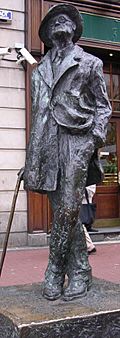
The poet W. B. Yeats was first influenced by old Irish myths and folk traditions. Later, he was drawn to more intellectual poetry and became one of the greatest 20th-century modernist poets. Even though Yeats was an Anglo-Irish Protestant, he was deeply affected by the Easter Rising of 1916 and supported Irish independence. He won the Nobel Prize for literature in 1923.
A group of early 20th-century Irish poets were linked to the Easter Rising of 1916. Three leaders of the rebellion, Patrick Pearse, Joseph Mary Plunkett, and Thomas MacDonagh, were also poets. Yeats's early style, which used Celtic themes, was very influential.
Irish Modernism in poetry was more influenced by James Joyce. The 1930s saw writers who experimented with their writing. The most famous of these is Samuel Beckett (1906–1989), who won the Nobel Prize in Literature in 1969. Beckett is best known for his plays, but he also wrote poetry.
While Yeats wrote about an aristocratic, old Gaelic Ireland, the real Ireland of the 1930s and 1940s was mostly made up of small farmers and shopkeepers. This led to a new generation of poets who wrote about the challenges of rural life, like Patrick Kavanagh (1904–1967). From the late 1950s onwards, new poets like Thomas Kinsella emerged. Many new literary magazines were started in Dublin in the 1960s and 1970s.
Forrest Reid (1875–1947) has been called the first important novelist from Ulster. His novel Following Darkness (1912) is a coming-of-age story set in Protestant Belfast.
James Joyce (1882–1941) is one of the most important novelists of the 20th century. He was a pioneer in using the "stream of consciousness" technique in his famous novel Ulysses (1922). Ulysses is seen as a major work of the entire Modernist movement. Joyce also wrote Finnegans Wake (1939), Dubliners (1914), and A Portrait of the Artist as a Young Man (1914–15). Ulysses tells the story of one day in Dublin. Finnegans Wake is a night epic, written in an invented language that mixes English, Irish, and Latin.
Joyce's modernist style influenced later Irish novelists, especially Samuel Beckett (1906–1989) and Flann O'Brien (1911–66). O'Brien was bilingual, and his fiction shows the influence of Irish storytelling and satire. Samuel Beckett, who won the Nobel Prize in Literature in 1969, is a huge figure in world literature. He is best known for his plays, but he also wrote novels like Watt and his trilogy Molloy, Malone Dies, and The Unnamable.
The "big house novel" continued into the 20th century, with writers like Elizabeth Bowen (1899–73).
With the rise of the Irish Free State and the Republic of Ireland, more novelists from lower social classes began to emerge. They often wrote about the limited lives of the lower-middle classes and small farmers. Examples include John McGahern (1934–2006). Other notable novelists of the late 20th and early 21st century include John Banville, Sebastian Barry, Edna O'Brien, Colm Tóibín, and William Trevor.
The Irish short story is a popular genre, with famous writers like Frank O'Connor and William Trevor.
Four Irish writers have won the Nobel Prize for Literature: W.B. Yeats, George Bernard Shaw, Samuel Beckett, and Seamus Heaney.
Literature of Northern Ireland
After 1922, Ireland was divided into the independent Irish Free State and Northern Ireland, which remained part of the United Kingdom. Northern Ireland has two main communities: Protestants (many of whom are Ulster Scots) and Irish Catholics. This division led to conflict known as The Troubles. This cultural split created two different literary traditions long before 1922.
C. S. Lewis (1898–1963) and Louis MacNeice (1907–63) were born in Northern Ireland but spent their careers in England. C. S. Lewis was a poet, novelist, and academic. He is best known for his fictional works, especially The Chronicles of Narnia (1949–54), and his non-fiction Christian writings. His faith deeply influenced his work.
Louis MacNeice was a poet and playwright. He was part of a group of poets in the 1930s. His work showed a dislike for harsh governments and a strong awareness of his Irish roots. MacNeice felt caught between British and Irish identities.
Northern Ireland has also produced many important poets since 1945, including John Hewitt, John Montague, Seamus Heaney, Derek Mahon, and Paul Muldoon. John Hewitt (1907–87) is often called the founder of Northern Irish poetry. Seamus Heaney (1939–2013) is the most famous of these poets and won the Nobel Prize in 1995. Heaney used words from his Ulster speech in his translation of Beowulf.
James Fenton writes poetry in contemporary Ulster Scots. Michael Longley (1939–) has also experimented with Ulster Scots. He feels both British and Irish, and the Good Friday agreement allowed him to feel more of each. Medbh McGuckian (born 1950) has won several awards for her poetry. Paul Muldoon (1951–) has published many collections and won a Pulitzer Prize for Poetry. Derek Mahon's (1941–) poetry is often "bleak and uncompromising."
The most important playwright from Northern Ireland is Brian Friel (1929–). He is known for plays like Philadelphia, Here I Come! and Dancing at Lughnasa. He has written over thirty plays and is highly respected.
Important novelists from Northern Ireland include Flann O'Brien (1911–66), Brian Moore (1921–1999), and Bernard MacLaverty (1942–). Flann O'Brien was a novelist, playwright, and satirist. His English novels, like At Swim-Two-Birds, were written under the name Flann O'Brien. His satirical columns and an Irish language novel An Béal Bocht were written under the name Myles na gCopaleen. O'Brien's novels are known for their strange humor and modern style. Brian Moore was praised for his descriptions of life in Northern Ireland after World War II. His novel Judith Hearne (1955) is set in Belfast. Bernard MacLaverty has written novels like Cal and Lamb, which describes the experiences of a young Irish Catholic involved with the IRA.
Other notable writers from Northern Ireland include science fiction novelist Bob Shaw (1931–96).
Theatre in Ireland
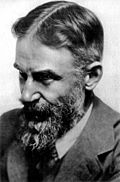
The first recorded play in Ireland was Gorboduc in 1601 at Dublin Castle. This started a trend, and private plays became common in large houses. The Werburgh Street Theatre in Dublin, built around 1637, is considered the first purpose-built theatre in the city outside London.
Early Irish playwrights of note include William Congreve (1670–1729), known for his comedies. Oliver Goldsmith (1730–74) and Richard Brinsley Sheridan (1751–1816) were two of the most successful playwrights in London in the 18th century.
In the 19th century, Dion Boucicault (1820–90) was famous for his melodramas. He became well-known on both sides of the Atlantic.
The Irish theatre really took off in the late 19th century with the founding of the Irish Literary Theatre in Dublin in 1899. Playwrights like George Bernard Shaw (1856–1950) and Oscar Wilde (1854–1900) became famous, though they wrote for the London stage. Shaw wrote over 60 plays and used theatre to discuss important social issues.
In 1903, playwrights and actors formed the Irish National Theatre Society, which later became the Abbey Theatre. It performed plays by W.B. Yeats (1865–1939), Lady Gregory (1852–1932), John Millington Synge (1871–1909), and Seán O'Casey (1880–1964). The Abbey Theatre created a unique style that influenced future Irish dramatists.
O'Casey was a socialist and the first Irish playwright to write about the working classes in Dublin. His plays, like The Shadow of a Gunman (1923) and Juno and the Paycock (1924), showed the impact of the Irish War of Independence and Irish Civil War on ordinary people.
The Gate Theatre, founded in 1928, introduced Irish audiences to classic plays from Ireland and Europe.
The 20th century saw many Irish playwrights rise to fame. These included Samuel Beckett (1906–89), Brendan Behan (1923–64), Hugh Leonard (1926–2009), and Brian Friel (1929–2015).

While Samuel Beckett was Irish, he lived much of his life in France and wrote many works in French first. His most famous plays are Waiting for Godot (1955) and Endgame (1957), which greatly influenced British drama.
In 1954, Behan's first play The Quare Fellow was produced in Dublin. His play The Hostage (1958), an English version of his Irish play An Giall, was very successful internationally.
During the 1960s and 1970s, Hugh Leonard became well-known for writing for television. His play Da (1978) was very successful on Broadway, winning him a Tony Award.
Brian Friel has been recognized as a major Irish playwright since his play "Philadelphia, Here I Come!" in 1964.
Tom Murphy is an important contemporary playwright. His plays include the historical epic Famine (1968), which deals with the Great Famine.
Frank McGuinness became famous with his play about World War I, Observe the Sons of Ulster Marching Towards the Somme (1985).
Since the 1970s, new theatre companies like Druid Theatre and Field Day have emerged. They have helped develop many talented writers, actors, and directors who have become successful worldwide.
- Irish Language Theatre
Traditional drama in Irish didn't exist before the 20th century. The Gaelic Revival encouraged playwriting, helped by the founding of An Taibhdhearc in 1928, a theatre dedicated to the Irish language. Although the Abbey Theatre became bilingual, the Irish language part became less important over time.
In 1957, Behan's play in Irish, An Giall, premiered in Dublin. Its English adaptation, The Hostage, later became very successful internationally.
Drama in Irish has faced challenges, but it continues thanks to groups like Aisling Ghéar.
More to Explore
 In Spanish: Literatura de Irlanda para niños
In Spanish: Literatura de Irlanda para niños
- Irish Gothic literature
- Irish prose fiction
- Irish poetry
- Irish short story
- Irish theatre
- Early Irish literature
- List of Irish writers
- List of Irish poets
- Literature of Northern Ireland
- Literature in the other languages of Britain
- Scottish Gaelic literature
|


